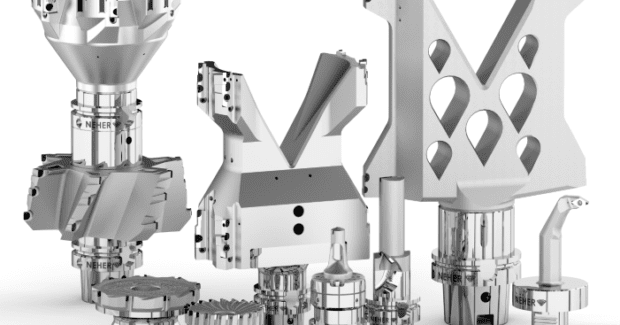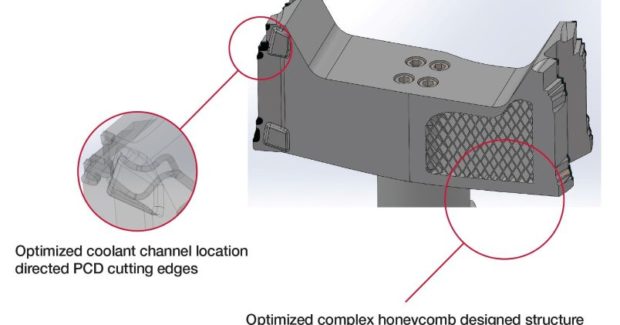3D Printed Tools Make an Impact
3D printing technology is becoming more mainstream. For example, AM allows for a high degree of freedom when designing a tool for a particular application.
Posted: October 20, 2021
ADDITIVE MANUFACTURING
By Christian Matheis and Jamie Dunneback
Additive manufacturing is making its way into the world of machining, providing some significant advantages, particularly in the area of large tools required for producing components for aerospace or automotive markets, including housings for electric motors. In our experience, application of this technology can result in a 30-to 50 percent tool life increase as compared to conventional manufacturing techniques.
In order to maximize the benefits of what 3D printed tools can offer, there is some basic knowledge that can help companies to develop tools best suited for their needs.
DESIGN AND MANUFACTURING
The most important step in making a 3D printed tool is the design of the tool. It must be ensured that the tool is both functional as well as manufacturable. The design needs to be able to withstand forces and vibrations that occur during the machining process, to properly create and evacuate chips, and to meet cooling requirements — all while being designed in such a way that it can be produced in a 3D printer.
In the case of internal structures such as cooling channels or lightweight geometries inside a tool, subsequent processing steps, drilling or milling for example, are usually not possible. Therefore, these structures must be designed so that post-processing is not necessary. However, external elements such as PCD pockets or chip flutes can be reworked, if necessary.
When it comes to the actual printing of the tool, this is accomplished with a laser that fuses metal layers with thicknesses between 0.03-and-0.10 mm. The 3D printers may incorporate SLM (selective laser melting) or SLS (selective laser sintering) to construct the tool. The tool can be printed in a variety of materials including plastic, aluminum, titanium, steel or stainless.
After the printing process has been completed, the components are removed from the construction chamber and freed from the residual powder and support material. The tool is then ready for subsequent process steps. As an example, this would include brazing the PCD into the pocket and finishing the tool to the print.
ADVANTAGES
In addition to the fact that additive manufacturing offers tool weight reduction that still maintains the rigiditly required for the machining process, there are several other advantages.
Another key benefit of this technology is its ability to produce geometries that cannot be achieved conventionally. The freedom enabled by 3D printing technology enables strategic placement of the coolant channels, optimizing its exit location by aiming directly at the cutting edges whereas in traditional tooling these holes are drilled into the monoblock body.
This ability to optimize coolant hole and cooling channel locations and improve tool damping, can improve tool life by 30 percent or more and is well suited to the growing, and environmentally-friendly MQL (minimum quantity lubrication) trend. Simple geometries based on the model of nature (bionics) can also be integrated into tools.
Eco-friendliness is another major benefit of additive manufacturing. For example, the energy efficiency of the 3D printer, which is significant and should not be overlooked. With a power consumption of approx. 4.6 kVA, the 3D printer electricity usage is drastically smaller than a milling machine with 60-70 kVA. If the turning and milling process is replaced by the printer, nearly 90 percent of the energy can be saved.
APPLICATIONS
Additively manufactured tools are used in all areas from small shell-type milling cutters for face milling all possible components to large boring bars or boring bits for e.g., electric motor housing. Additive manufactured tools can be a good solution for companies looking to reduce the weight of the tool, which may be required due to the size of the spindle interface.
The machining of stator housings of electric motors, in particular, is well suited to this technology. It requires very large tools with several teeth for economical machining. However, existing machines are often not designed to accommodate such heavy tools. That is why the tools need to become lighter without sacrificing any performance capability.
The use of additive manufacturing enables a high degree of design freedom to optimize a tool for a particular application. This benefit is in addition to the production of a lighter tool that maintains all necessary mechanical properties while also reducing preventative maintenance. Traditional steel body monoblock tools will certainly maintain their market position for years to come. However, it‘s clear that 3D printing technology, once thought of as a technique only for prototyping, has become a mainstream production process.













